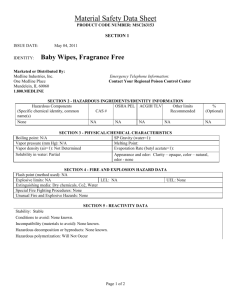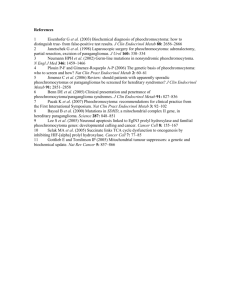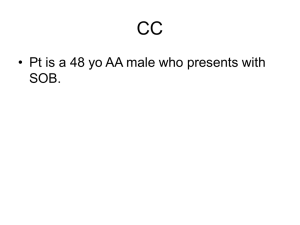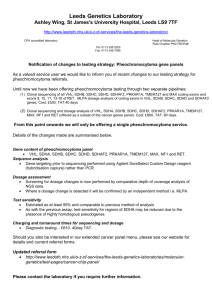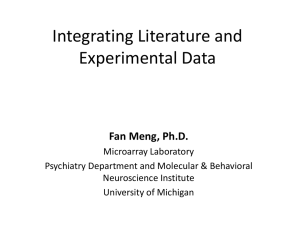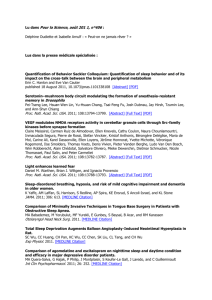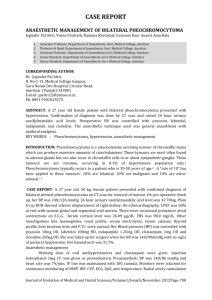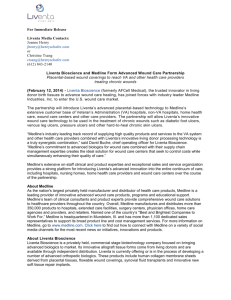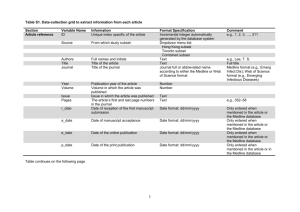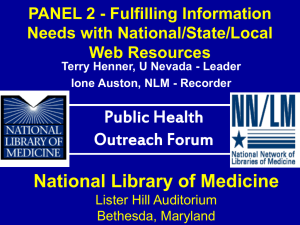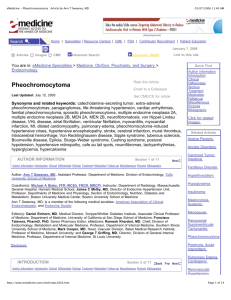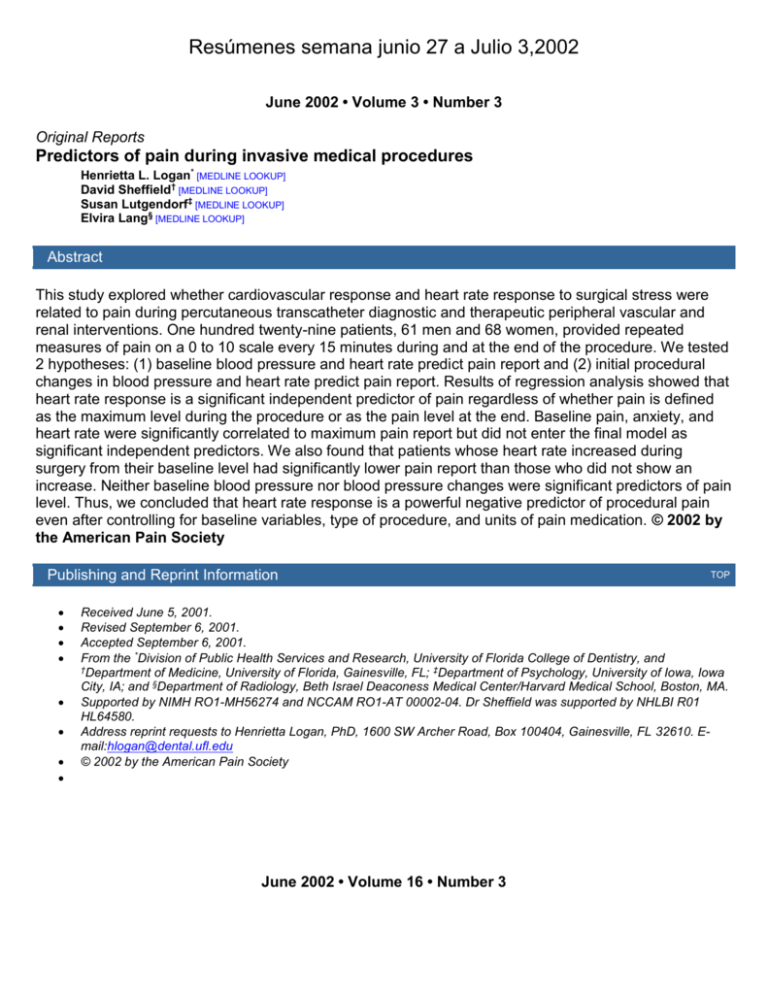
Resúmenes semana junio 27 a Julio 3,2002
June 2002 • Volume 3 • Number 3
Original Reports
Predictors of pain during invasive medical procedures
Henrietta L. Logan* [MEDLINE LOOKUP]
David Sheffield† [MEDLINE LOOKUP]
Susan Lutgendorf‡ [MEDLINE LOOKUP]
Elvira Lang§ [MEDLINE LOOKUP]
Abstract
This study explored whether cardiovascular response and heart rate response to surgical stress were
related to pain during percutaneous transcatheter diagnostic and therapeutic peripheral vascular and
renal interventions. One hundred twenty-nine patients, 61 men and 68 women, provided repeated
measures of pain on a 0 to 10 scale every 15 minutes during and at the end of the procedure. We tested
2 hypotheses: (1) baseline blood pressure and heart rate predict pain report and (2) initial procedural
changes in blood pressure and heart rate predict pain report. Results of regression analysis showed that
heart rate response is a significant independent predictor of pain regardless of whether pain is defined
as the maximum level during the procedure or as the pain level at the end. Baseline pain, anxiety, and
heart rate were significantly correlated to maximum pain report but did not enter the final model as
significant independent predictors. We also found that patients whose heart rate increased during
surgery from their baseline level had significantly lower pain report than those who did not show an
increase. Neither baseline blood pressure nor blood pressure changes were significant predictors of pain
level. Thus, we concluded that heart rate response is a powerful negative predictor of procedural pain
even after controlling for baseline variables, type of procedure, and units of pain medication. © 2002 by
the American Pain Society
Publishing and Reprint Information
TOP
Received June 5, 2001.
Revised September 6, 2001.
Accepted September 6, 2001.
From the *Division of Public Health Services and Research, University of Florida College of Dentistry, and
†Department of Medicine, University of Florida, Gainesville, FL; ‡Department of Psychology, University of Iowa, Iowa
City, IA; and §Department of Radiology, Beth Israel Deaconess Medical Center/Harvard Medical School, Boston, MA.
Supported by NIMH RO1-MH56274 and NCCAM RO1-AT 00002-04. Dr Sheffield was supported by NHLBI R01
HL64580.
Address reprint requests to Henrietta Logan, PhD, 1600 SW Archer Road, Box 100404, Gainesville, FL 32610. Email:hlogan@dental.ufl.edu
© 2002 by the American Pain Society
June 2002 • Volume 16 • Number 3
Original Articles
Renal tubular injury after infrarenal aortic aneurysm repair
Gillian Cressey, FRCA [MEDLINE LOOKUP]
D.R. Digby Roberts, FRCA [MEDLINE LOOKUP]
Christopher P. Snowden, FRCA [MEDLINE LOOKUP]
Abstract
TOP
Objective: To investigate markers of tubular injury (glutathione-S-transferase [GST] isoforms) as early
markers for renal damage in patients undergoing abdominal aortic aneurysm repair.
Design: Prospective study.
Setting: Regional teaching hospital.
Participants: Eight consecutive patients undergoing elective infrarenal abdominal aortic aneurysm
repair.
Interventions: All patients received a standard anesthetic technique including a dopamine infusion (3
µg/kg/min) but without supplemental renoprotective agents. Urine and blood samples were taken at
induction, at 1 hour and 3 hours after limb reperfusion, and on days 1 and 2 postoperatively. Urine
microalbumin and creatinine concentrations were measured using standard assays, and urine -GST
and -GST enzyme measurements were performed by a commercial immunoassay (Biotrin, Biotrin
International Ltd., Co., Dublin, Ireland).
Measurements and Main Results: Five patients (63%) showed a postoperative elevation of serum
creatinine (median increase from baseline, 35.4%; range, 8.3% to 50.6%) that was associated with
significant elevations of urinary microalbumin-to-creatinine, -GST-to-creatinine, and -GST-to-creatinine
ratios soon after clamp removal. The remaining 3 patients showed no increase in serum creatinine or
urine proteins. Peak -GST-to-creatinine levels were different between the 2 groups. The peak levels of
GST enzymes were significantly (r2 > 80%) associated with the percent increase in serum creatinine
from baseline.
Conclusion: Urinary GST-to-creatinine ratios are a sensitive early biomarker for renal injury after
infrarenal abdominal aortic aneurysm repair.
Copyright 2002, Elsevier Sceince (USA). All rights reserved.
Publishing and Reprint Information
TOP
From the Department of Anaesthetics, Northampton Hospital; Department of Anaesthetics, Freeman Hospital; and
Dept. of Surgical Sciences, University of Newcastle upon Tyne, Newcastle upon Tyne, United Kingdom.
Address reprint requests to Christopher P. Snowden, FRCA, Department of Anaesthetics, Freeman Hospital,
Newcastle upon Tyne, NE7 7DN UK. E-mail: c.p.snowden@ncl.ac.uk .
Copyright 2002, Elsevier Sceince (USA). All rights reserved.
June 2002 • Volume 16 • Number 3
Original Articles
Neuroprotection is associated with -adrenergic receptor antagonists during cardiac
surgery: Evidence from 2,575 patients
David W. Amory, MD, PhD [MEDLINE LOOKUP]
Alina Grigore, MD [MEDLINE LOOKUP]
John K. Amory, MD [MEDLINE LOOKUP]
Mark A. Gerhardt, MD, PhD [MEDLINE LOOKUP]
William D. White, MPH [MEDLINE LOOKUP]
Peter K. Smith, MD [MEDLINE LOOKUP]
Debra A. Schwinn, MD [MEDLINE LOOKUP]
J. G. Reves, MD [MEDLINE LOOKUP]
Mark F. Newman, MD [MEDLINE LOOKUP]
the Duke University Perioperative Organ Protection Consortium*
Abstract
TOP
Objective: To determine the impact of perioperative -adrenergic receptor ( AR) antagonist
administration on neurologic complications.
Design: Observational database analysis.
Setting: A clinical investigation at a single tertiary academic medical center.
Participants: Elective coronary artery bypass graft surgical patients operated on in the period 19941996.
Interventions: Patients were divided into 2 groups: (1) patients given AR antagonist–blocking drugs in
the perioperative period, including during operation, and (2) patients not given AR antagonists.
Measurements and Main Results: AR antagonist use in 2,575 consecutive patients undergoing
coronary artery bypass graft surgery (1994-1996) was determined using the Cardiovascular Database
and Anesthesia Information System Database. Outcome variables were postoperative stroke, coma, and
transient ischemic attack. Of patients, 113 (4.4%) had postoperative neurologic complications, including
stroke (n = 44), coma (n = 12), and transient ischemic attack (n = 3). Of patients, 2,296 (89%) received
perioperative AR antagonist therapy, and 279 (11%) did not. Adverse neurologic events occurred in
3.9% (n = 90) of patients who received perioperative AR antagonists and 8.2% (n = 23) of patients who
did not receive AR antagonists (odds ratio, 0.45; 95% confidence interval, 0.28 to 0.73; p = 0.003,
unadjusted.) Severe neurologic outcomes (stroke and coma) occurred in 1.9% (n = 44) of patients who
received AR antagonists and 4.3% (n = 12) of patients who did not receive AR antagonists (odds
ratio, 0.43; 95% confidence interval, 0.23 to 0.83; p = 0.016).
Conclusion: Use of -adrenergic antagonists was associated with a substantial reduction in the
incidence of postoperative neurologic complications. A prospective randomized trial is needed to verify
this potentially important neuroprotective strategy in cardiac surgery.
Copyright 2002, Elsevier Science (USA). All rights reserved.
Publishing and Reprint Information
TOP
*See Acknowledgment.
From the Division of Cardiothoracic Anesthesiology, Department of Anesthesiology, Duke University Heart Center,
Durham, NC; Department of Medicine, University of Washington, Seattle, WA; Department of Anesthesiology, Ohio
State University Medical Center, Columbus, OH; Department of Surgery, Duke University Medical Center, Durham,
NC; and Department of Anesthesiology, Medical University of South Carolina, Charleston, SC.
Supported by NIH grants RO1-AG09663 (J.G.R.), 1RO1-HL54316 (M.F.N.), RO1-HL57447 (D.A.S.), KO2-AG00545
(D.A.S.), #HL57447 (D.A.S.), and AG00745 (D.A.S.), American Heart Association Grant-In-Aid, #95010970 (M.F.N.),
and NIH MOI-RR-30.
Presented in part at the Society of Cardiovascular Anesthesiologists 21st Annual Meeting, Chicago, IL, April 24-28,
1999.
Address reprint requests to Mark F. Newman, MD, Duke University Medical Center, Box 3094, Durham, NC 27710.
E-mail: newma005@mc.duke.edu
Copyright 2002, Elsevier Science (USA). All rights reserved.
June 2002 • Volume 16 • Number 3
Editorial
Pheochromocytoma: Specialist cases that all must be prepared to treat?
David L. Bogdonoff, MD [MEDLINE LOOKUP]
Sections
References
Publishing and Reprint Information
THIS ISSUE IS rich with content pertinent to the management of pheochromocytoma, with special
attention to cases arising from the heart. There are 2 interesting case reports, a focused review article,
and expert commentary on the case conference. The case reports raise the question of whether
experienced specialists are needed to manage a patient with a pheochromocytoma or whether the
average well-trained anesthesiologist is capable of managing such cases.
Medical progress on many fronts has helped change the management of pheochromocytoma from that
of a risky undertaking to one approaching routine. Regardless of these advances, an unsuspected case
can be encountered, possibly resulting in disaster. This situation is analogous to that with malignant
hyperthermia, a disease process in which the underlying abnormalities now are well understood down to
the molecular level. Although malignant hyperthermia once carried significant mortality, the management
of susceptible individuals and the treatment of intraoperatively diagnosed cases are well worked out and
within the scope of expertise of all anesthesiologists. The same is becoming true for
pheochromocytoma, as modern practitioners are able to remove these tumors with near-zero mortality
compared with a fatality rate of about 50% just 2 or 3 decades ago.
The diagnosis of pheochromocytoma historically has been problematic because of imperfect sensitivity
and especially specificity of laboratory tests. A high index of suspicion is necessary to determine when to
screen for this rare disease, responsible for only 0.1% of all cases of hypertension. Absence of
headache, sweating, or palpitations is suggested to virtually eliminate the diagnosis, but these
symptoms are common in clinical practice.1 Investigations into the varied metabolic pathways of
catecholamines have permitted the discrimination, at least in part, of the metabolism of intraneuronally
derived catechols from those that are released from a pheochromocytoma or normal adrenal gland
directly into the systemic circulation. Screening for plasma metanephrines and normetanephrines,
derived preferentially from circulating catecholamines, has become the best test to rule out
pheochromocytoma. Although still not universally available at all centers, screening blood tests for these
catecholamine metabolites are suggested to have sensitivity and negative predictive values approaching
100%, exceeding that of urine screening tests and serum tests for other metabolites or catecholamines
themselves.2 Consequently, diagnostic protocols should be simplified and improved. The sensitivity of
these tests is now being combined with genetic screening of potentially susceptible individuals. 3 Families
prone to pheochromocytoma, such as those with multiple endocrine neoplasia type II, von Hippel–
Lindau disease, and neurofibromatosis type 1, may have their tumors identified earlier, permitting safer
surgical treatment before the tumors cause greater cardiovascular derangement.
Surgical advances in the treatment of pheochromocytoma have accompanied improvements in the
localization of tumors. Resection of pheochromocytoma previously required a large intra-abdominal
incision, necessitated by the need to search for contralateral and extra-adrenal coexisting tumors.
Tumors were identified by palpation of the opposite adrenal gland and periaortic regions while the
anesthesiologist observed accompanying hemodynamic changes. Extra-adrenal neoplasms, constituting
10% to 20% of some large series of pheochromocytomas, were difficult to diagnose, presented later in
the course of illness, and were more metabolically active, making their resection much more
problematic. Significant progress has been made in various imaging studies. Computed tomography is
still the best modality to image adrenal tumors, whereas magnetic resonance imaging may have some
advantages for extra-adrenal tumors.3 These enhancements in imaging have led to an increased
diagnosis of adrenal incidentalomas, requiring the use of the better screening techniques for
catecholamine metabolites previously discussed. The addition of radionuclide scanning offers superior
specificity in imaging pheochromocytomas, and is readily accomplished using radioactive iodine-labeled
meta-iodobenzylguanidine (MIBG), which is taken up by these active tumors. Ongoing research is
underway with other labels and positron emission tomography. These improvements in imaging and
localization have allowed surgeons to eliminate the use of large incisions and the need to search the
abdomen for additional tumors. Smaller and less morbid posterior or flank incisions are often employed
for tumor resection. Advances in minimally invasive surgical technique now permit the removal of
pheochromocytomas laparoscopically without any increase in the incidence of adverse intraoperative
hemodynamic sequelae.4
Accompanying these advances in diagnosis and surgery for this disease have been many advances in
anesthesiology, including better monitors and monitoring techniques, better drugs, and a parallel
improvement in the quality and training of anesthesiologists. The quality and expertise of modern
anesthesiology practice may be evident by the noteworthy omission of the specialty at an
interdisciplinary National Institutes of Health conference on research and advances in care of patients
with pheochromocytoma.3
The first major advance in the treatment of pheochromocytoma resulted from the preoperative
preparation of the patient using the -blocking drug phenoxybenzamine. Restoration of circulating blood
volume, prevention of dangerous hypertensive episodes before and during surgery, and correction of
potentially dangerous myocardial toxicity from the excess circulating catecholamines have been the
major contributions of this preoperative therapy. Phenoxybenzamine remains the gold standard against
which other therapies must be compared. There is still dogmatic insistence on its use for at least 2
weeks preoperatively, although many experts have retreated from this stance and find a shorter
treatment period adequate.5,6
Many other preoperative blockade approaches have been used, including more selective 1-blocking
drugs (eg, prazosin or terazosin), calcium channel–blocking drugs, and labetalol with its combined and –blocking properties. A large series reported by an advocate of selective 1-blockade (prazosin)
failed to show any difference in outcome between patients treated with -blockade and patients who
received no -blockade at all.6 It is possible that better understanding of this disease and improved
ability to detect and treat intraoperative changes have made the preoperative preparatory phase a less
crucial issue for most cases of pheochromocytoma.
Metyrosine ( methyl para-tyrosine) blocks tyrosine hydroxylase, the rate-limiting step in the synthesis of
catecholamines. As such, metyrosine has direct application to the treatment of pheochromocytoma as
an adjunct to the use of -blockade.7,8 This drug has been available for clinical use for several decades
and although used routinely at some centers, it is ignored too often in others.9 Side effects are
unpleasant for the patient, so noncompliant patients may present for surgery. The elegance of this
approach is that catecholamine levels are lowered throughout the body, leading to better control of
preoperative and intraoperative hemodynamic disturbances.7,8
It is this author's opinion that the length of preoperative treatment needs to be tailored to the patient's
condition. The existence of cardiac dysfunction, although rare, is an indication for prolonged treatment
with -blockade. A few days of treatment are probably is sufficient for most other patients because this is
likely to allow some reregulation of -adrenergic receptors to more normal levels. Unpredictable
responses to -adrenergic agonists are more likely without a brief period of preoperative blockade,
making the treatment of intraoperative hypotension problematic. The author has found metyrosine to be
a highly useful adjuvant therapy. It is the most elegant therapy and comes the closest to a medical cure
for the patient (metyrosine is the treatment for metastatic and inoperable pheochromocytoma). The
intraoperative course of patients has been hemodynamically smoother in the author's last 25 to 35
cases, when metyrosine was used preoperatively in combination with -blockade.
There are 2 major sources of catecholamine release that cause concern during the management of the
patient with pheochromocytoma. Chronic high levels of circulating catecholamines originating from the
tumor eventually lead to an excess of catecholamines in the termini of all sympathetic neurons. This
overload is the result of catecholamine reuptake mechanisms that are present in sympathetic nervous
system neurons, normally used to terminate the effects of synaptically released norepinephrine. This
explanation has been validated by work examining dihydroxyphenylglycol (DHPG), a deaminated
metabolite of norepinephrine formed mainly in sympathetic neurons and not in adrenal tissue. DHPG
levels have been correlated with hypertensive crises, suggesting that catecholamine release from the
peripheral neurons is the cause of these episodes and not necessarily release from the tumor itself.10 As
a consequence of such enhanced neuronal stores of norepinephrine, any condition that leads to a
stimulation of the sympathetic nervous system (eg, anxiety or pain) results in excessive release of
transmitter and an exaggerated physiologic response, which can be just as problematic as the
unpredictable release of vasoactive hormones from the tumor itself. The conditions that reliably stimulate
a sympathetic response in the operating room are, however, relatively predictable (arterial catheter
insertion, intubation, incision) and can be approached with caution, preparation, and vigilance.
The direct release of hormones from the pheochromocytoma has been reported to occur intraoperatively
with positioning changes, insufflation of the peritoneal cavity during laparoscopy, and tumor manipulation
itself. There may be other unknown factors that could stimulate tumoral catecholamine release.
Circulating concentrations of epinephrine and norepinephrine can be 1 to 2 orders of magnitude higher
than the normal levels.5,11 Regardless of the degree and duration of preoperative preparation, actions
may need to be taken in the operating room to deal with significant catecholamine-induced physiologic
insults occurring during the course of the procedure. The ability of anesthesiologists to meet this
challenge is facilitated by using drugs with which they have considerable experience. Most practitioners
use nitroprusside for initial blood pressure control because its rapid onset and short half-life make it a
practical therapeutic option. Many other drugs have been reported to be effective, including
trimethaphan camsylate, nitroglycerin, nicardipine, and fenoldopam. The short-acting -blocker
phentolamine, magnesium, and esmolol can be useful adjuncts for particularly difficult cases.
Additionally, rapid titration of inhalation anesthetic concentration can be brought to bear, especially
facilitated by the newer less soluble agents, sevoflurane and desflurane. The author has found the
combination of intravenous and inhalation drugs to be safer because they are more rapidly titratable and
less likely to result in overshoot hypotension.
Regional anesthesia can also be used effectively, but its use must be balanced against the risk of
adverse hemodynamic sequelae. Preoperative insertion runs the risk of hypertension during placement,
although the author has not observed this effect with adequate sedation and an experienced practitioner.
Use of local anesthetic may help to block sympathetic nervous system responses to stimulation but may
complicate fluid management after adrenal vein ligation, leading to aggravation of hypotension.
Several other issues can make the perioperative course of pheochromocytoma more complicated. Rare
tumors produce only epinephrine, resulting in vastly different symptoms, such as hypotensive episodes.
Release of other substances, such as dopamine, also leads to unpredictable responses. Some may
argue that these patients should be sent to centers with extensive case experience. A strong argument
can also be made, however, that most skilled and attentive anesthesiologists, using the array of
anesthetic agents, adjuvants, and cardiovascular drugs now available, should be able to manage a
patient with pheochromocytoma who has been appropriately prepared for surgery.
As shown by the case reports in this issue, the possibility of encountering an undiagnosed, and
untreated, pheochromocytoma always exists. Vigilant anesthesiologists need to be prepared and
knowledgeable in the treatment of these patients, just as they need to be for a new case of malignant
hyperthermia.
TOP
References
1. Plouin PF, Chatellier G, Delahousse M, et al: Recherche, diagnostic et localization du
pheochromocytoma: 77 cas dans une population de 21,420 hypertendus. Presse Med 16:22112215, 1987
MEDLINE
2. Lenders JW, Keiser HR, Goldstein DS, et al: Plasma metanephrines in the diagnosis of
pheochromocytoma. Ann Intern Med 123:101-109, 1995
MEDLINE
3. Pacak K, Linehan WM, Eisenhofer G, et al: Recent advances in genetics, diagnosis,
localization, and treatment of pheochromocytoma. Ann Intern Med 134:315-329, 2001
MEDLINE
4. Sprung J, O'Hara JF Jr, Gill IS, et al: Anesthetic aspects of laparoscopic and open
adrenalectomy for pheochromocytoma. Urology 55:339-343, 2000
MEDLINE
CROSSREF
5. Newell KA, Prinz RA, Brooks MH, et al: Plasma catecholamine changes during excision of
pheochromocytoma. Surgery 104:1064-1073, 1988
MEDLINE
6. Boutros AR, Bravo EL, Zanettin G, Straffon RA: Perioperative management of 63 patients
with pheochromocytoma. Cleve Clin J Med 57:613-617, 1990
MEDLINE
7. Perry RR, Keiser HR, Norton JA, et al: Surgical management of pheochromocytoma with the
use of metyrosine. Ann Surg 212:621-628, 1990
MEDLINE
8. Steinsapir J, Carr AA, Prisant LM, Bransome ED Jr: Metyrosine and pheochromocytoma. Arch
Intern Med 157:901-906, 1997
MEDLINE
9. Prys-Roberts C: Phaechromocytoma—recent progress in its management. Br J Anaesth
85:44-57, 2000
MEDLINE
10. Atuk NO, Hanks JB, Weltman J, et al: Circulating dihydroxyphenylglycol and norepinephrine
concentrations during sympathetic nervous system activation in patients with pheochromocytoma.
J Clin Endocrinol Metab 79:1609-1614, 1994
MEDLINE
11. Fernandez-Cruz L, Saenz A, Taura P, et al: Helium and carbon dioxide pneumoperitoneum
in patients with pheochromocytoma undergoing laparoscopic adrenalectomy. World J Surg
22:1250-1255, 1998
MEDLINE
Publishing and Reprint Information
TOP
Departments of Anesthesiology and Surgery
Medical Director, Perioperative Services
Vice Chair for Clinical Affairs
Department of Anesthesiology
University of Virginia Health System
Charlottesville, VA
Copyright 2002, Elsevier Science (USA). All rights reserved.
BMJ 2002;324:1475 ( 22 June )
News
Emotional exhaustion and stress in doctors are linked
Susan Mayor, London
Emotional exhaustion and stress have been found to be directly associated in the results of a longitudinal study of
UK doctors published last week (Lancet 2002;359:2089-90).
The study was designed to assess the causal relation between stress and burnout in doctors, based on the
recognition that these linked problems are common in healthcare professionals.
One of the research team, Professor Chris McManus, professor of psychology and medical education, University
College London, explained: "Despite being common in health workers 15-20% of UK doctors show significant
stress the development and causal relations of burnout and stress are unclear, in part due to an absence of
adequate longitudinal studies."
To resolve these unknowns, a stratified sample of 800 doctors was selected at random from the UK Medical
Directory a list of all registered doctors in the country and their stress levels were followed over three years.
The group selected included equal numbers of men and women and of hospital doctors and family practitioners
who qualified in five year bands between 1950-9 and 1990-4. One in five doctors in each age, sex, and type of
practice had qualified outside the United Kingdom.
The stress levels of the doctors taking part in the study were assessed by using the 12 item version of the general
health questionnaire. Burnout was measured with the Maslach burnout inventory, which includes subscales of
emotional exhaustion, depersonalisation (cynicism), and personal accomplishment (professional efficacy). The
551 doctors who completed the questionnaires in 1997 were asked to complete them again three years later, in
2000; 382 (69%) of them responded.
Results showed a reciprocal causation between exhaustion and stress. The largest causal effects in the model
showed a causal cycle in which high levels of emotional exhaustion caused stress (standardised regression
coefficient, b=0.189) and high levels of stress caused emotional exhaustion (b=0.175).
"Emotional exhaustion is probably the key precursor of stress," Professor McManus
explained. "Doctors who become emotionally exhausted become stressed. This then
leads to them becoming more emotionally exhausted and even more stressed." High
levels of personal accomplishment increased stress levels (b=0.080).
In contrast, depersonalisation treating patients as objects rather than as people
lowered stress levels (b=0.105).
The authors suggested that this might have occurred through a Freudian type of "ego
defence" mechanism. Professor McManus warned: "The key part of the equation is emotional exhaustion. We have
got to find a way to reduce this. Reduced workload would help."
He suggested that the current emphasis on encouraging doctors to care more about patients as individuals and to
reach higher personal achievements, without adequate time and support, was adding to stress and burnout in
doctors.
The survey was funded by the General Medical Council as a part of its audit of the performance procedures.
Professor McManus explained that it was the first study of its kind to look at stress levels over time.
CMAJ • June 25, 2002; 166 (13)
© 2002 Canadian Medical Association or its licensors
Research
Recherche
Research letter
Risk of death or readmission among people discharged from hospital on
Fridays
Carl van Walraven and Chaim M. Bell
Dr. van Walraven is with the Department of Medicine, University of Ottawa, and the Clinical Epidemiology
Unit, Ottawa Health Research Institute, Ottawa, Ont., and the Institute for Clinical Evaluative Sciences,
Toronto, Ont. Dr. Bell is with the Department of Medicine and the Institute of Medical Sciences, University of
Toronto, Toronto, Ont.
Correspondence to: Dr. Carl van Walraven, Clinical Epidemiology Unit, Ottawa Health Research Institute,
Rm. F-660, Ottawa Hospital — Civic Campus, 1053 Carling Ave., Ottawa ON K1Y 4E9; fax 613 761-5351;
carlv@ohri.ca
The timing of patient interventions can significantly affect outcomes. A study in the United Kingdom showed that
patients discharged from intensive care units at night had a higher hospital mortality than those discharged during
the day.1 In a study of acute care admissions from emergency departments in Ontario, patients with some serious
medical conditions were more likely to die in hospital if they were admitted on a weekend than if they were
admitted on a weekday.2
Do patients discharged on Fridays have worse outcomes than those discharged on other days? Friday is the most
common hospital discharge day.3 More discharges could result in patients receiving fewer discharge instructions
from hospital staff.4 Perhaps because of decreased staffing on weekends5 and physician cross-coverage, patients
may be preferentially discharged on Fridays rather than on subsequent weekend days. Some patients discharged on
Fridays could therefore leave hospital before they are fully stable. Also, new home health and social support
services for weekend discharges often are not initiated until the following Monday. Such a delay may result in poor
outcomes for patients discharged on Fridays who need these services initiated immediately.
For this study we used anonymous data from population-based administrative databases for Ontario. Data for all
adults discharged from hospital to the community between Mar. 1, 1990, and Mar. 1, 2000, were extracted from the
Discharge Abstract Database (DAD), which records all discharges from Ontario hospitals. For patients with 2 or
more admissions, we randomly chose 1 admission for each patient using a random-number generator. Only
nonelective admissions were included in the study.
We used proportional hazards modelling to determine the association between discharge day and nonelective
readmission to hospital (measured using the DAD) or death (measured using the Registered Patient Database)
within 30 days after discharge while controlling for potential confounders. These confounders were determined
from the DAD and included age, sex, comorbidities (measured using the Charlson–Deyo score6), nonelective
hospital admission during the 6 months before the index admission, length of stay, whether a procedure was
performed and whether a complication occurred. In the proportional hazards model, patients were observed for 30
days after discharge or until the occurrence of an event (nonelective readmission or death). Databases were linked
using common patient identifiers. The study was approved by the Sunnybrook & Women's College Health Sciences
Centre Research Ethics Board.
A total of 2 403 181 patients met our inclusion criteria. Friday was the most common discharge day (Fig. 1).
Overall, 7.1% of the patients had an event (5.4% were readmitted, 1.7% died) in the 30 days following discharge.
Compared with the reference group (people discharged on Wednesdays), those discharged on Fridays were
significantly more likely to have an event (hazard ratio 1.04, 95% confidence interval 1.02–1.05) (Fig. 1). This
effect was independent of patient and hospital admission factors (Table 1).
Fig. 1: Risk of death or nonelective hospital readmission within 30 days
after discharge from hospital, by day of discharge. Bars represent
proportion of discharges by day of the week. Hazard ratios (HRs) of
death or readmission within 30 days (diamonds) and 95% confidence
intervals (error bars) are relative to Wednesday discharges. The HRs
are independent of patient factors (e.g., age, sex, comorbidities and
previous hospital admission) and hospital admission factors (e.g.,
length of stay, presence of complication or procedure, and teaching
View larger version (25K): status of hospital) but are not independent of the volume of discharges
on that day.
[in this window]
[in a new window]
View this table: Table 1.
[in this window]
[in a new window]
Patients discharged from hospital on Fridays had an increased independent risk of death or nonelective hospital
readmission within 30 days after discharge. This may have been because these patients were less medically stable
than those discharged on other days or because the discharge preparation was incomplete owing to competing
demands on clinicians' and hospital staff's time from multiple discharges on Fridays. It could also be due to a delay
in implementing social services. Until further research clarifies why Friday discharges are associated with worse
outcomes than are discharges on other days, we suggest that clinicians keep this observation in mind if they
consider pushing to get patients home for the weekend.
Footnotes
This article has been peer reviewed.
Contributors: Both authors contributed to the study concept and design, the analysis and
interpretation of data, the drafting and revising of the manuscript and the approval of the
final version.
Acknowledgements: Dr. van Walraven is an Ontario Ministry of Health Career Scientist. Dr.
Bell is the recipient of Clinician-Scientist Awards from the Canadian Institutes of Health
Research and the Department of Medicine, University of Toronto.
Competing interests: None declared.
Top
References
References
1. Goldfrad C, Rowan K. Consequences of discharges from intensive care at night. Lancet 2000;355:113842.[Medline]
2. Bell CM, Redelmeier DA. Mortality among patients admitted to hospitals on weekends as compared with
weekdays. N Engl J Med 2001;345(9):663-8.[Abstract/Full Text]
3. Basinski AS. Use of hospital resources. In: Naylor CD, Anderson GM, Goel V, editors. Patterns of health
care in Ontario. Toronto: Canadian Medical Association; 1994. p. 165-306.
4. Alibhai SM, Han RK, Naglie G. Medication education of acutely hospitalized older patients. J Gen Intern
Med 1999;14(10):610-6.[Medline]
5. Moore JD Jr. Hospital saves by working weekends. Mod Healthc 1996; 26 (46):82,84,99.
6. Deyo RA, Cherkin DC, Ciol MA. Adapting a clinical comorbidity index for use with ICD-9-CM
administrative databases. J Clin Epidemiol 1992;45 (6):613-9.[Medline]

